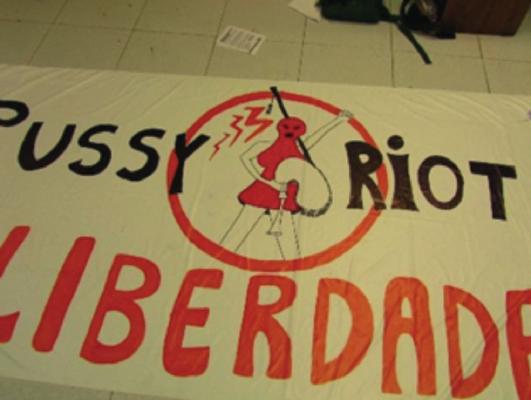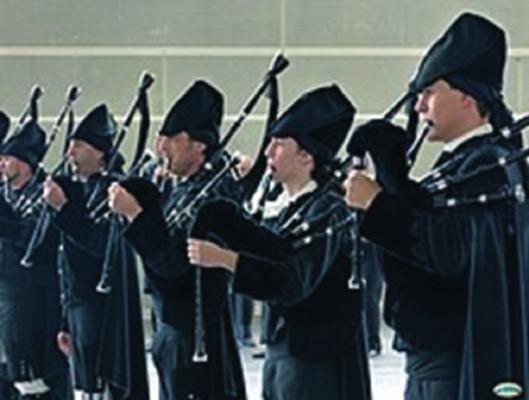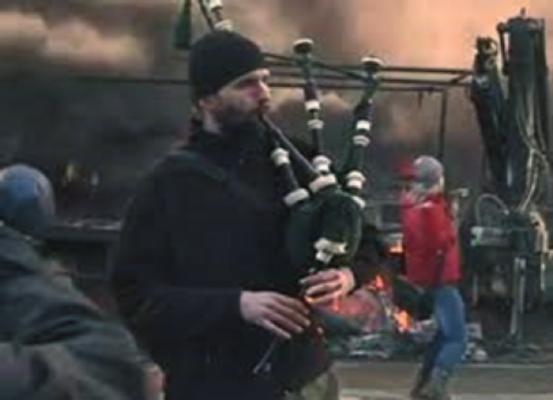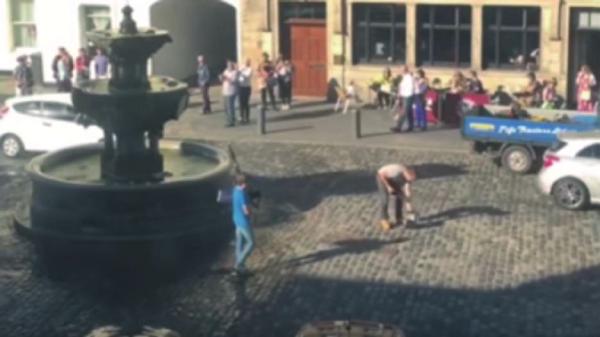The Bagpipe Society
The bagpipe as an instrument of protest: early references and recent trends
A short note in the Autumn 2021 edition of Chanter about the detention of a number of people who were playing bagpipes during a mass demonstration in Minsk resonated with me.1 References also occur in a range of historical sources to the use of the instrument in various types of protest situations in 17th and 18th century Ireland. Collating and reviewing these occurrences leads one to determine that the practice is quite well established. The Great Highland Bagpipe is probably the instrument that most readily springs to mind if one mentions ‘bagpipe’ and ‘protest’ in the same sentence, although that bagpipe is not the only one used in protest situations. As an instrument widely associated, in the first instance, with the Highland clans in Scotland and later with Scottish regiments of the British Army, which then spread to the various colonies, it is frequently associated with war-time, military occasions, official public activities, funerals, parades, celebrations and ceremonies of various kinds wherever it is found across the globe. The Great Highland Bagpipe also has the distinction of being a much louder instrument than most other types of pipe readers of Chanter will know of and play, and therefore lends itself more readily to the public arena and the phenomenon of demonstration and protest. However, as will be seen from various examples mentioned in this article, other types of bagpipe are widely used in the context of protest and have been for some time. Roderick Cannon has shown how widely across England, Scotland and further afield, indeed, the bagpipe was generally known as a ‘pastoral instrument’ and he cites many examples from literature and art in the sixteenth and seventeenth centuries (and later) that support this contention.2 In many cases, various types of pipe were deemed an ideal instrument for outdoor activity such as herding stags, as well as indoor events such as entertaining guests at court.3 However, given the strength of sound and volume associated with some pipes, their use wasn’t always welcomed by the general populace. Cannon informs us, for instance, that a piper named Humphrey Sydenham appeared before magistrates in West Somerset in 1592 because he had interrupted a religious service taking place at the time by ‘causing dyvers baggepipes to be blown to the grete dishonour of Almighty God’.4 As evidence of a more welcoming response in other places, however, he provides several examples of pipers being enlisted to draw attention to public notices made by town criers and the like, although it is not always clear that the term ‘piper’ referred specifically to the playing of a bagpipe rather than some flute-like instrument.5 Use of the pipes in similar contexts was a feature of the cultural life of the gentry in early eighteenth-century Ireland where pipers and harpists performed for audiences and patrons in their houses. One example of this describes how the wife of the Church of Ireland bishop of Killala, Robert Clayton, occupied the place of honour at the local sports day, returning home in the evening to ‘dancing, singing … accompanied with an excellent bagpipe, the whole concluded with a ball, bonfire and illuminations’. The event described was held in 1732.6
Cannon has provided examples from England and Scotland of pipers being employed to play for labourers such as sheep-shearers and reapers, their apparent function to entertain the workers and encourage productivity among them. It is noted, however, that the piper ‘generally keeps behind the slowest worker’ in an attempt, one imagines, to encourage productivity and keep the individual on track.7 Travelling showmen appearing at fairs used itinerant pipers to attract attention to their particular act or performances so that they could ‘walk the streets in triumph and give notice of our sport’.8 Pipers were employed as a means to attract the attention of the public in Ireland, too. The German traveller, Johann Georg Kohl, described the travelling theatres in Kilkenny during the race meeting as a group of wagons crowded in a semi-circle.
‘In front of each waggon a stage or balcony was erected where the showmen, the trumpeters, the bagpipers and the drummers were constantly screaming, blowing, making speeches or attempting, by pantomimic gestures, to make themselves understood by the gaping crowds … the chief inducement was … that the admission was only one halfpenny.’9
In August 1896, for example, during what is usually referred to as the Revival period, a deputation from the Belfast branch of Conradh na Gaedhilge (The Gaelic League) visited the Omeath district of Co. Louth in Ireland, to try and arouse popular feeling among the people for the preservation and promotion of the Irish language. As the members canvassed the local residents, the entourage was preceded by an Irish piper, presumably to draw attention to their presence and thus to the purpose of their activities.10
So, while many of the references we have associate pipers and the playing of a bagpipe with social and civic events such as weddings, fairs or other forms of entertainment, Cannon concludes that piping in the north of England gradually died out in the seventeenth and eighteenth centuries. In that process of fading he makes the interesting observation that the tradition faded ‘in a northerly and perhaps westerly direction’ and in due course became associated – certainly in the mind of the southern population – with Scotland, Presbyterianism and rebellion.11 Perhaps his assertion that ‘the southern population’ associated the bagpipe with Scotland and ‘rebellion’ had more to do with historical tensions between Scotland and England than anything else.
In any event, his use of the word ‘rebellion’ conjures up notions of civic, social and political unease and leads one to consider the role of the bagpipe in such situations. References to the use of the bagpipe in the context of conflict can be traced back at least to the mid-1500s and Roderick Cannon amassed a range of sources which indicated that in Gaelic Scotland and Ireland, the bagpipe was a favoured instrument ‘as the incitement to battle’. Drawing on Jean de Beaugné’s L’histoire de la Guerre d’Ecosse (Paris, 1556) and referring to the Battle of Pinkie near Edinburgh in 1549, Cannon notes de Beaugné’s comment that ‘while the French prepared for combat, the wild Scots encouraged themselves to arms by the sound of their bagpipes’.12 Scottish historian, George Buchanan, remarked in 1581 of the fighting Scots that ‘instead of the trumpet they use the bagpipe’. Sir James Ware wrote that ‘the Irish kearns and idlemen used a bagpipe instead of a drum in war’. Richard Stanishurst stated sometime around 1584 that the Irish used a bagpipe instead of a trumpet in battle. >
‘It is evident that this instrument must be a very good incentive to their courage at the time of battle, for by its tones, the Irish are stirred up to fight in the same manner as the soldiers of other nations by the trumpet.’13
Interestingly, similar accounts were reported in respect of the Irish elsewhere. In London in 1544, for example, Irish soldiers marched ‘with bagpipes before them’.14 Some decades later, Vincenzio Galileo, writing about the bagpipe in his Dialogo della musica antico e moderna (1581), noted ‘It is much used by the Irish; to its sound this fierce, unconquered and warlike people march their armies and encourage each other to deeds of valour.’15
During a period of notoriously bitter religious tension and animosity in the rising of the early 1640s in Ireland, one manifestation of anti-Protestant fervour was the destruction of the printed word by Catholic insurgents. Devotional texts were generally displayed in churches in such a manner as to indicate the reverence in which the Protestant community held them. Depositions taken from witnesses about the harrowing events reported to have been perpetrated on communities on both sides of the religious divide in the years following the 1641 rebellion contain many accounts of the destruction of books. Religious volumes, including the Bible, were reportedly burned at the high cross in Belturbet (Co. Cavan), Armagh and Meath, for example.16 One of these accounts – from County Wexford – is particularly interesting in that it records the use of a bagpipe as part of the desecration. The witness’s account states ‘And they went into the Church and cutt the pulpit cloth and the minister’s books in peeces, and strewed them about the churchyard, and caused the piper to play while they daunced and trampled them under their feete’.17 Thus, although somewhat isolated, this is a good example of the instrument’s association with situations in which religious conflict and acrimony were a key feature.
Turning to some of the examples of how the bagpipe has been used in situations of protest in more recent times, one can see how widely the instrument is drawn upon for this purpose. It is also clear that certain patterns may be identified concerning the use of the bagpipe in these situations. For example, (1) those holding a protest may use the instrument as a means of attracting attention to their cause; (2) alternatively, the bagpipe may be used to disrupt a demonstration or to attempt to ‘close down’ such activities; (3) there are examples of the instrument being deployed by the piping community itself as part of ‘in-house’ cultural disagreements; (4) and there are examples of images of the instrument itself – or even songs – being used as a symbol for protest.18 Scholars of protest have written about various types of demonstration and a body of academic work is growing around the concept of ‘protest theory’. One useful example of the thinking of scholars can be found in an essay written by Thomas Ratliff and Lori Hall in 2014.19 While they looked in particular at the concept of protest as it is practised in the United States, their discussion of the art of dissent has a much broader application. In their article, the authors identify six basic types of protest methods, the associated activities of which may be summarised as follows:
Protest Methods
| Type | Associated Activity | |
|---|---|---|
| 1 | Symbolic/Aesthetic/Sensory | Street theatre, dancing, speeches, chanting, leaflets, petitions, destruction of objects with symbolic value or religious significance |
| 2 | Solemn/Sacred | Vigils, prayers, candle-lighting, rallies in religious services or of religious groups |
| 3 | Institutional/Conventional | Formal political processes, press conference, lawsuits, lobbying |
| 4 | Movement in space | Marches, parades, picket lines, quite often in symbolic places |
| 5 | Collective Violence/Threats | Pushing/shoving, hitting, punching, damaging property, throwing objects, making verbal threats |
| 6 | Civil Disobedience | Withholding obligations, sit-ins, blockades, occupations, or other activities which technically break the law |
With the possible exception of No. 5, the use of the bagpipe at a protest under any one of the other five categories would not be surprising and many examples of these could be cited. The classification outlined by Ratliff and Hall would provide a useful framework for anyone examining and attempting to classify those situations in which a bagpipe forms part of the protest strategy. In an essay on the Galician piping tradition, Mano Panforreteiro has examined the involvement of pipes and pipers in a broader socio-cultural context in an interesting article he wrote for Chanter in 2017.20 He notes that the bagpipe has been a key instrument in political protest in Galicia and is referenced widely in the nationalist nature of its music and song tradition.21 Another example he cites was the use of the gaita in the Marea Gaiteira (Pipers’ Tide) demonstration, organised in 2002 as a political protest against the government’s mismanagement of the ecological disaster that resulted from the spillage of crude oil from the tanker, Prestige. Panforreteiro notes that the bagpipe and the pipers who participated in the protest ‘were used as symbols of an empowered Galician community’.22 The power of even the image of the bagpipe is something else noted by Panforreteiro. In the Piper Pussy Riot as part of the 2010 Women’s March, the organisers adopted the image of a female gaita player as a symbol of the campaign for women’s rights and the image was used everywhere.23

On the other hand, tensions within the Galician piping community itself have also resulted in protests involving the use of the bagpipe – piper versus piper, so to speak. One example of such a protest was the emergence of a new type of Galician band in Ourense in the mid-1990s. The group imitated the approach of Scottish bands by wearing kilts, adopting a different bagpipe design and musical arrangement and practising a style of playing that was deemed to be almost ‘military’ in nature. The common opinion among the Galician piping fraternity was that such a development was ‘alien to the Galician tradition’. In what was referred to at the time as a guerra das gaitas between those keen to preserve the traditions associated with the instrument as opposed to those who sought to encourage its musical development and evolution, some critics referred to the new style of band as gaita marcial (military bagpipe). The Director of the Real Banda de Ourense was expelled from the Associación de Gaiteiros de Galicia and the traditional pipers staged public protests at events attended by the new type of bands.24

In 2014 reports appeared in the Scottish press about a piper (who asked to be referred to only as Eugene), who was involved in anti-Russian protests in Kyiv, Ukraine in the early part of that year. He was a self-taught piper who had been playing the bagpipe for about five years at the time, usually only at Scottish-themed weddings and other cultural functions in Ukraine. In the course of the interview with reporters, however, he revealed that he had been greatly inspired by the pipers who marched with Scottish soldiers during the Second World War. In an interesting comparison to the experiences of many pipers during the two world wars, Eugene said of his experience at the protest:
‘The police began firing rubber bullets and lead shots. One rubber bullet hit me in the ear but I’m okay … I don’t know what made me play but I was not scared. I was careful. When musicians play during a riot, it means the people involved are not terrorists or extremists. It means they are normal people fighting for their rights and their state. I was emotional given what was happening around me. I played to support the protesters but I played because I am a protester, too. Based on my experience, I can now imagine what bagpipers felt during battles.’25

Eugene also stated that he thought the bagpipe was a perfect instrument for the occasion because those protesting were fighting for Ukraine to remain independent of Russia. He also stated: ‘Music is very important where people are fighting for their future. It does not matter even what instrument you play but, oddly enough, the great Scottish bagpipes fit very well into this role. In most cases I played Ukrainian folk tunes and people reacted positively. People thanked me and asked me to play more as the bagpipes gave them moral support.’26 The idea of ‘moral support’ as part of protest is a recurring theme where the pipes are played at such events. The bagpipe may also be used as a means to obstruct an activity deemed by people to be socially unacceptable. In September 2015, for instance, a young teenager played his pipes in an attempt to drown out a street preacher reported to have been including discriminatory messages in his monologues. The preacher was captured in footage while using a loudspeaker on Market Street in St Andrews, Scotland and it was reported that he was shouting anti-Muslim and homophobic slurs. Perturbed by what was going on and apparently reading the mood of the public, the teenage piper took out his pipes and walked up to the preacher playing ‘Scotland the Brave’.27 Passers-by began cheering and a short time afterwards, the police arrived. The young man explained to a news reporter: ‘I had my bagpipes in my dad’s car and someone suggested drowning him out, so I got them and started playing. Everyone started cheering. It was great.’ Police Scotland said officers were called to a ‘noise complaint’ on a Saturday afternoon and dealt with the issue very quickly. The incident, caught on camera, was subsequently posted on the ‘Overheard in St Andrews’ Facebook page, was also reported on the BBC news and from there quickly went viral. It is an example of the pipes being used in a very effective way to protest at – and, indeed, in this case – to neutralise an activity that people present on the occasion clearly felt was not acceptable.28

In another instance of the bagpipe being used as a means of challenging a protest, an incident involving protesters concerned about climate change was widely reported in the press. A group known as Insulate Britain had closed one of the busiest roads in the UK in an attempt to draw attention to the perceived lack of action by the British government in tackling the challenge of climate change. Insulate Britain staged the protest to demand that the UK government insulate all social housing by 2025 and retrofit all homes with state-of-the-art insulation by 2030. Outraged by the inconvenience the protest created for other road-users, an angry Scottish motorist got out of his car, took out his bagpipes and began playing in protest at the roadblock, kneeling provocatively in front of protestors who were sitting on the road. (See photo.) The event was captured in a video, which was then posted on Twitter. Police in attendance at the scene intervened quickly and moved the unnamed bagpiper away. Addressing his remarks to the camera, the man said: “They’re holding up ambulances, fire trucks.” However, Twitter users criticised the police for intervening to move the piper but not the protestors who had blocked the road. One user, Henry Jameson, said: “Playing the bagpipes is deemed more of a nuisance to the public than gluing yourself to the floor of a busy road and blocking all traffic.” Another, named Muriel Gray, added: “The police moved this piper chap on for ‘obnoxiously playing the bagpipes in the protestor’s face’. Well excuse me! Up here we pay good money for that kind of excellent entertainment.”29

In September 2021, Catholic protesters gathered at New York’s Lincoln Centre ahead of the New York Film Festival premiere of Paul Verhoeven’s lesbian nun drama, Benedetta, set in 17th-century Italy. The film stars Virginie Efira as Benedetta Carlini, who joins a convent as a novice and has an affair with another nun. Catholic protestors were upset about the film’s ‘blasphemous’ portrayal of nuns and Catholicism. They repeatedly prayed the Hail Mary into megaphones and some of the protestors played bagpipes, presumably as a way of drawing attention to their grievances.30 The piper is seen in the photo wearing a red sash, which may simply indicate membership of one of the Catholic groups involved in organising the protest. It is possible that the individual concerned just happened to be a piper and brought his instrument along to help draw the public’s attention to the nature of the protest or it may also be the case that he was active in the organization and brought his bagpipe with him to enhance the protest. Either way, the purpose of his attendance at the event is clear and it had the desired effect in that it drew the attention of journalists reporting the event in various media. Pipers are often seen at such protests in North America – especially where there is a religious element involved. Pipers have featured at protests organized outside abortion clinics in the United States, for example. They are also popular at other protests which may involve regional or localized issues for communities. Another contributor to this journal has described his involvement in a campaign in Canada against the oil and fuel industry out of major ecological and cultural concerns, as well as damage to the indigenous people of the region. In an interesting observation on his use of the instrument itself, the author noted that while the bagpipe is
‘in some respects a symbol of a historically oppressed people … the Scottish bagpipes, including their more recent British military affiliation, are also a reflection of colonialism in North America.’31
Conclusion
There is no doubt about the popularity of the bagpipe as part of the act of protest at various types of demonstration. Even the limited range of examples mentioned in this article makes that clear. The fact that one can trace the use of the instrument in protest or conflict situations back some centuries is a further indication that the phenomenon is not of a more recent provenance. The bagpipe is a powerful instrument in its own right and thus draws attention to whatever is happening around it whenever and wherever it is used. In fact, it is likely the case that it becomes even more effective in places where it is less commonly heard played. Its power as an aide to protest rests not only with its unique sound and visual effect but also with the manner in which it can often symbolise or represent a particular aspect of national culture, religious belief, as well as a broad range of political and social concerns. The fact that it appeals so readily to human emotion also makes it an attractive instrument for protest and, given its popularity as part of public demonstration, it is clear that it helps to rouse and encourage fervour where it is used by those involved in protest situations. Of course, as is also evident from some of the examples cited here, it has a similar effect on those who oppose a particular demonstration and attempt to interfere with it by way of counter-protest. While the bagpipe is a musical instrument that is part of a very rich cultural heritage of communities in countries across the world, its use as part of protest situations also highlights the versatility of the instrument in its range of purpose. Whatever the reason for its use at any particular event, one thing that cannot be denied is its popularity in protest situations in many different cultures. In that respect, it might also be said that in its own right, it actually functions as an aide to civic, political and social discourse. The engagement here with the use of the bagpipe as an instrument of protest has been merely an initial attempt at teasing out the issue. There is an opportunity here to do further interesting research into the use of the bagpipe in the context of protest and to draw on the literature that is emerging about the theory of protest. The possibilities for looking at the question from a number of different angles are intriguing and this very common practice among the piping fraternity would benefit from more rigorous and in-depth scrutiny.
### References
- Eugen Baryshnikau, ‘News from Belarus’, Chanter (Autumn 2021), Vol. 35, No. 3, pp 2-3.
- R.D. Cannon, ‘The bagpipe in northern England’ in Peter Stewart (ed.), Essays on the bagpipe in England – Its history, music and iconography: A celebration of the pioneering work of Dr Roderick Cannon (The Bagpipe Society, 2014), 12-13.
- Cannon, ‘The bagpipe in northern England’, pp 12-13.
- Cannon, ‘The bagpipe in northern England’, p. 14.
- Cannon, ‘The bagpipe in northern England’, p. 17.
- S.J. Connolly, Religion, law and power: The making of Protestant Ireland, 1660-1760 (Oxford: Clarendon Press, 2000), pp 131-2.
- Cannon, ‘The bagpipe in northern England’, p. 19.
- Cannon, ‘The bagpipe in northern England’, pp 21-22.
- Johann Georg Kohl, Travels in Ireland (London, 1844), p. 205.
- Irisleabhar na Gaedhilge, September 1896.
- Cannon, ‘The bagpipe in northern England’, p. 21.
- Roderick D. Cannon, The highland bagpipe and its music (Edinburgh, 2002; first edn, 1998), p. 8. The English quotation is in John Graham Dalyell’s Musical Memoirs of Scotland. (Edinburgh/London, 1849) He, in turn, drew on de Beaugné’s original text in French: ‘Les Ecossois sauvages se provoquoyent auz armes par les sons de leurs cornemeuses.’
- Cited in ‘The music of Scotland’, The Irish University Magazine, vol. 2 (Jul-Dec, 1833), pp 55-64 at pp 63-4. No author is given, although much of the text is reproduced by Joseph Warren in a later essay. (See fn 14.) Stanishurst’s description of the bagpipe is worth reproducing in full here. ‘The Irish, likewise, instead of the trumpet make use of a wooden pipe of the most ingenious structure, to which is joined a leathern bag very closely tied with bands; a pipe is inserted in the side of this skin, through which the piper, with his swollen neck and puffed up cheek, blows in the same manner as we do through a tube. The skin, being thus filled with air, begins to swell and the player presses against it with his arm; thus a loud and shrill sound is produced through two wooden pipes of different lengths. In addition to these, there is yet a fourth pipe perforated in different places, which the player so regulates by the dexterity of his fingers in the shutting and opening the holes, that he causes the upper pipes to send forth either a loud or low sound at pleasure. The principal thing to be taken care of is that the air be not allowed to escape through any other part of the bag than that in which the pipes are inserted, for if anyone were to make a puncture in the bag, even with the point of a needle, the instrument would be spoiled and the bag would immediately collapse.’
- Roderick D. Cannon, The highland bagpipe and its music (Edinburgh, 2002; first edn, 1998), p. 8.
- Joseph Warren, ‘On the national instrument of Scotland – the bagpipes’ in The musical world, no. 227 (30 July, 1840) and 228 (6 August, 1840), p. 90. (Warren draws heavily on information provided in The University Magazine cited in fn 12.)
- 1641 Depositions, Trinity College Dublin. https://1641.tcd.ie/. Accessed 30 December, 2021.
- Deposition of Henry Palmer, 12/1/1642, 1641 Depositions, Trinity College Dublin, MS 818, fols 088r-089v, http://1641.tcd.ie/index.php/deposition/?depID=818088r107&Keywords=piper. Accessed 30 December, 2021. The spelling in the original document is retained here.
- See Mano Panforreteiro, ‘Pipes and pipers: Galician symbols of ever evolving meaning’ in Chanter, Vol. 31, No. 2 (Summer 2017), pp 46-53 at pp 51-2 and Nathan Hayward, ‘Piping against a pipeline with First Nations song’ in Chanter, Vol. 33, No. 3 (Autumn 2019), pp 15-17 at p. 16.
- Thomas N. Ratliff and Lori L. Hall, ‘Practicing the art of dissent: Toward a typology of protest activity in the United States’ in Humanity & Society 38.3 (2014), pp 268-94.
- Panforreteiro, ‘Pipes and pipers’, pp 46-53.
- Ibid, pp 51-2.
- Ibid, p. 51.
- Ibid.
- See Xelís de Toro, ‘Bagpipes and digital music: The re-mixing of Galician identity’ in Jo Labanyi (ed.), Constructing identity in contemporary Spain: theoretical debates and cultural practice (Oxford, 2002), pp 237-54 at p. 247
- https://www.dailyrecord.co.uk/news/uk-world-news/ukraine-protests-brave-bagpiper-relives-3168243.
- Ibid.
- See footage of the incident on this YouTube video: https://www.youtube.com/watch?v=JwLaDzKFiBY.
- See https://www.thecourier.co.uk/news/fife/250933/it-was-great-piper-who-shut-down-street-preacher-is-amazed-by-internet-stardom/ and https://www.bbc.com/news/uk-scotland-edinburgh-east-fife-34313750.
- See https://www.heraldscotland.com/politics/19677204.insulate-britain-m25-scots-bagpiper-interrupts-obnoxious-protestors/; https://www.thetimes.co.uk/article/insulate-britain-protests-ink-thrown-over-activists-as-tempers-fray-5rw7hk9qm
- See https://www.indiewire.com/2021/09/paul-verhoeven-benedetta-nyff-premiere-catholic-protest-1234667479/
- Nathan Hayward, ‘Piping against a pipeline’, pp 15-17.
By Macmurchaidh, Ciarán Trad Various
From Chanter Autumn 2022.
- Data Processing Notice (GDPR)
-
@BagpipeSociety on X (formally known as Twitter)
-
TheBagpipeSociety on Instagram
-
 BagpipeSociety on Facebook
BagpipeSociety on Facebook
Something wrong or missing from this page? Let us know!
